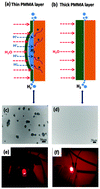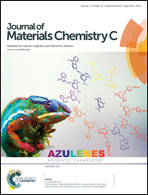Pore-free bubbling delamination of chemical vapor deposited graphene from copper foils†
Abstract
The electrolytic bubbling-assisted transfer of graphene from metal catalysts in chemical vapor deposition provides a high efficiency, low cost and environmental benign alternative to the traditional chemical etching method. Despite its high potential, the yield of bubbling delamination is yet low, mainly due to the induced pores in the graphene after the transfer. It is found that water and protons transported through the poly(methyl methacrylate) (PMMA) supporting layer play a critical role in pore formation. Once water and protons reach the PMMA–graphene interface before delamination is finished, the protons permeate the graphene and form trapped hydrogen bubbles between the graphene and the metal. The built-up gas pressure inside the bubbles is high enough to crack the PMMA/graphene sheet, thereby creating pores in the graphene. An optimized PMMA layer not only reduces trapped hydrogen bubble generation, but it is also mechanically stronger preventing cracking. This contributes significantly to the pore-free electrolytic bubbling-assisted delamination of graphene.


 Please wait while we load your content...
Please wait while we load your content...